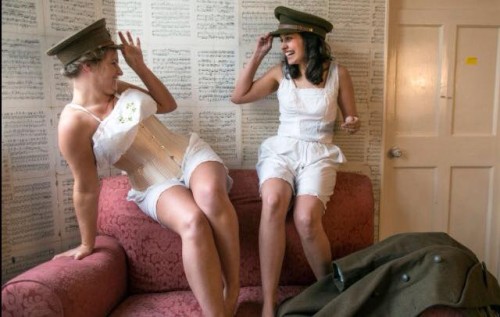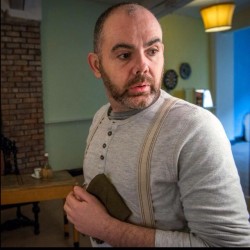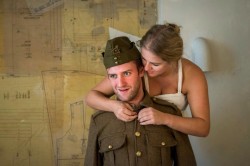Buglight Theatre’s The House Behind the Lines comes out of recent research into brothels in France during World War One used by troops with their superior’s tacit agreement. This is very much a taboo subject with the majority of the research evidence based on letters home from the men, none from the women involved in supplying their wares.
Throughout Keeley Lane as Lisbet the Madame dominates the stage not just because of her risqué costume but her body language and each gesture and facial expression giving an insight into her complex character. She inducts coquette Molly (played with fiery gusto by Mez Galaria) into the ways of the trade and Molly soon becomes the star girl.
One theatrical device used effectively is to refer to action off-stage without ever showing is it so it avoids being a voyeuristic sordid sex spectacle and can concentrate on developing the characters and narrative. It far from glorifies the sex trade in any way with Molly, right from the start, clutching her private parts in pain and telling tales of what some of the men expect for the money.
In fact, she divides her punters up into types, preferring those who are so shy they do next to nothing but write her a little love poem. She appears auto de fe with her role though (has she done this all before in Paris?) but it is her relationship with Major General Hargreaves that is of most interest.
Lee Toombes as Hargreaves plays a tough rather reticent leader who wants the brothel to be given over to officers only and cleaned up (gonorrhoea and syphilis have no use in the army even if relieving the troops’ sexual frustrations does). He takes Molly on board as a project, despite not wanting sex with her or any of the other girls, giving her books which he is keen to discuss.
Then there is Ryan, a warrant officer played by Richard Galloway, who is taken under the wing of the Madame and a love affair is developing, but a happy romance in war is an incredibly rare thing, if not impossible with the Sword of Damocles swinging all around . Galloway depicts Ryan’s shellshock with verve and veracity and his frustrations of never really being able to fulfil his dreams due to the catastrophe all around him.
It is here that we see Lisbet’s more maternal side, full of compassion and care, and this is similar to the sense of camaraderie she feels with the girls, especially her favourite Molly, and a part of her power over the men who come to her establishment as much for a sense of home as the saucy services on offer.
Surprisingly there is little bawdy Carry On-style humour, but then we are all adults here, not adolescents after a cheap thrill. So the subjects of sex and death are taken head on with eyes wide open but there are no easy answers either. Neither the men or women are condemned or condoned, all four main characters are left with their lives ahead of them like an open book, not narrowly defined.
It is here that, as an experimental production prior to a possible full-scale show, Buglight ask the audience for their opinions and suggestions. I would back up the general acknowledgement that the piece already has great worth and stature, unusual in both form and content but effective nonetheless.
I felt some of the multi roles were a tad too close together for us to be ready to redefine character and status and, as you might expect, some of the staging and blocking was a bit wayward. But there really is something to hold on to here and I don’t consider more back story or a lengthy second act would particularly be of benefit.
Buglight deserve plaudits for their incredibly hard work in developing and displaying this piece which presents powerful performances (especially the irrepressible Keeley Lane) and a concept that really sets you ruminating about what it must have been like for both genders in such a bordello at a time of international and individual crisis.
As seen in development at Bradford Playhouse, 16 January.
Click here to read Rich Jevons interview with Keeley Lane prior to the show.


